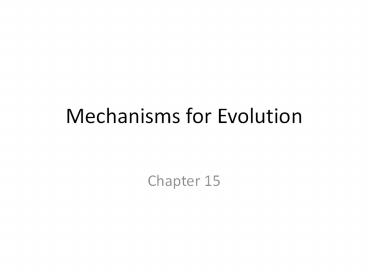Mechanisms for Evolution - PowerPoint PPT Presentation
Title:
Mechanisms for Evolution
Description:
Mechanisms for Evolution Chapter 15 Populations and Evolution Population a group of organisms that interbreed Each population shares a gene pool (the different ... – PowerPoint PPT presentation
Number of Views:78
Avg rating:3.0/5.0
Title: Mechanisms for Evolution
1
Mechanisms for Evolution
- Chapter 15
2
Populations and Evolution
- Population a group of organisms that interbreed
- Each population shares a gene pool (the different
alleles present in the population) - Each population has a relative frequency of each
allele, or the number of times the allele occurs
in the gene pool. - The frequency of alleles in a population tends
not to change unless there is an outside force
causing the change
3
Evolution occurs because of changes to the
equilibrium
- There are 5 mechanisms that can change the allele
frequencies in a population - Natural Selection
- Genetic Drift
- Mutation
- Migration
- Non-random Mating
4
1. Natural Selection
- Natural selection is a process by which
individuals who are more fit for their
environment survive and reproduce more often - Allele frequencies change because of interactions
between the population and the environment - There are 4 different types of natural selection
- a. Stabilizing Selection
- b. Directional Selection
- c. Disruptive Selection
- d. Sexual Selection
5
1a. Stabilizing Selection
- Stabilizing selection occurs when individuals
with the average form of a trait are most fit for
the environment and extreme traits are eliminated - This is the most common form of natural selection
6
Example of stabilizing selection
- Lizard body size
- Large lizards are easily seen by predators, but
smaller lizards cannot run as fast to escape the
predators - Mid sized lizards are most fit in the
environment, so they survive and reproduce more
often, changing the allele frequencies in the
population
7
1b. Directional Selection
- Directional selection occurs when individuals
with one extreme variation of a trait are the
most fit in the environment. - This causes a gradual shift in allele frequency
to that extreme (shift in one direction).
8
Example of Directional Selection
- Anteater tongue length
- Anteaters with long tongues are most fit because
of the depth of the nests of the termites they
eat.
9
1c. Disruptive Selection
- Disruptive selection occurs when both extreme
variations of a trait are the most fit. - There is selection against the middle variations.
- This type of selection often results in new
species being created.
10
Example of Disruptive Selection
- Ex Limpet shells
- Dark limpets blend with bare rocks
- Light limpets blend with barnacle covered rocks
- Tan limpets are visible in both situations and
get preyed upon more often by birds
11
1d. Sexual Selection
- Sexual selection is the competition for mates
within a population causing differences to occur
in the allele frequencies of the two genders - Often results in extreme differences in the
physical appearance of males and females. - Mates tend to be chosen for their phenotypes and
females tend to choose the males.
12
1d. Sexual Selection contd
- Ex Peacocks
- Male peacocks have large tail feathers that make
it difficult to fly and escape from predators. - Female peacocks choose males based on their tail
feather length and fullness. - Over time males with larger tail feathers
reproduce more causing large tails to be more
common. - Sexual Selection in Peacocks
13
2. Genetic Drift
- Genetic drift describes changes in allele
frequency due to population size. - Allele frequencies can change more rapidly in
smaller populations
14
Genetic Drift Demo
- 1. What do the marbles in the bottle represent?
- 2. Describe the allele frequencies of the
original population in the bottle. - 3. How are the allele frequencies in the final
population different from the original
population? - 4. What sorts of events might cause genetic drift
to occur?
15
2. Genetic Drift contd
- The founder effect
- occurs when a few
- individuals from a larger
- population colonize a
- new area.
- Ex. Amish community
- The allele frequency
- of this population may
- differ from the larger
- population because of the
- limited number of individuals
16
3. Mutations
- Mutations are inheritable changes to the
- genotype of an organism
- Mutations occur randomly and spontaneously within
a population - Many mutations are harmful, but some are useful
- Mutations can affect allele frequency in a
population by - 1. Adding new alleles for a trait
- 2. Changing the amount of each allele
present - It can take a long time to eliminate a mutation
and a long time for a new mutation to become
prevalent
17
4. Migration
- Movement into and out of a population can change
the allele frequency in a gene pool - Immigration can ADD individuals with variations
to the population - Emigration can REMOVE individuals with variations
from a population - Gene flow which is the process of transferring
genes among different populations
18
5. Non-Random Mating
- Having a limited number of individuals can also
impact mating. - Non-random mating can influence allele
frequencies because - Mates can be limited by geography
- Mates can be chosen for their traits
- Mates can be more closely related to one another































